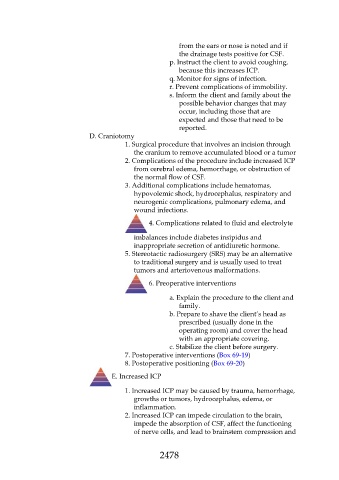Page 2478 - Saunders Comprehensive Review For NCLEX-RN
P. 2478
from the ears or nose is noted and if
the drainage tests positive for CSF.
p. Instruct the client to avoid coughing,
because this increases ICP.
q. Monitor for signs of infection.
r. Prevent complications of immobility.
s. Inform the client and family about the
possible behavior changes that may
occur, including those that are
expected and those that need to be
reported.
D. Craniotomy
1. Surgical procedure that involves an incision through
the cranium to remove accumulated blood or a tumor
2. Complications of the procedure include increased ICP
from cerebral edema, hemorrhage, or obstruction of
the normal flow of CSF.
3. Additional complications include hematomas,
hypovolemic shock, hydrocephalus, respiratory and
neurogenic complications, pulmonary edema, and
wound infections.
4. Complications related to fluid and electrolyte
imbalances include diabetes insipidus and
inappropriate secretion of antidiuretic hormone.
5. Stereotactic radiosurgery (SRS) may be an alternative
to traditional surgery and is usually used to treat
tumors and arteriovenous malformations.
6. Preoperative interventions
a. Explain the procedure to the client and
family.
b. Prepare to shave the client’s head as
prescribed (usually done in the
operating room) and cover the head
with an appropriate covering.
c. Stabilize the client before surgery.
7. Postoperative interventions (Box 69-19)
8. Postoperative positioning (Box 69-20)
E. Increased ICP
1. Increased ICP may be caused by trauma, hemorrhage,
growths or tumors, hydrocephalus, edema, or
inflammation.
2. Increased ICP can impede circulation to the brain,
impede the absorption of CSF, affect the functioning
of nerve cells, and lead to brainstem compression and
2478

